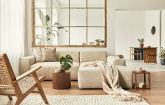NEW YORK, Jan. 21, 2025 /PRNewswire/ -- Report with market evolution powered by AI - The luxury furniture market in middle east size is estimated to grow by USD 401.7 million from 2025-2029, according to Technavio. The market is estimated to grow at a CAGR of 4.2% during the forecast period. Increase in number of office spaces is driving market growth, with a trend towards increasing acceptance and demand for eco-friendly products. However, growing prominence of furniture rentals poses a challenge. Key market players include Anna Casa Ltd., Auraliving, B and B Italia SPA, Boca Do Lobo, DelightFULL, Giorgio Armani SpA, Haworth Inc., Inter IKEA Holding BV, Lazzoni Furniture, Luma Inc., LVMH Moet Hennessy Louis Vuitton SE, MillerKnoll Inc., Minotti SpA, Natuzzi SpA, Next Space LLC, Pan Emirates Home Furnishings, Poltrona Frau SPA, Scavolini S.p.a., and Workspace.
Key insights into market evolution with AI-powered analysis. Explore trends, segmentation, and growth drivers- View Free Sample PDF
Luxury Furniture Market In Middle East Scope |
|
Report Coverage |
Details |
Base year |
2024 |
Historic period |
2019-2023 |
Forecast period |
2025-2029 |
Growth momentum & CAGR |
Accelerate at a CAGR of 4.2% |
Market growth 2025-2029 |
USD 401.7 million |
Market structure |
Fragmented |
YoY growth 2022-2023 (%) |
4.0 |
Regional analysis |
Middle East |
Performing market contribution |
Middle East at 100% |
Key countries |
Saudi Arabia, UAE, Kuwait, Oman, and Rest of Middle East |
Key companies profiled |
Anna Casa Ltd., Auraliving, B and B Italia SPA, Boca Do Lobo, DelightFULL, Giorgio Armani SpA, Haworth Inc., Inter IKEA Holding BV, Lazzoni Furniture, Luma Inc., LVMH Moet Hennessy Louis Vuitton SE, MillerKnoll Inc., Minotti SpA, Natuzzi SpA, Next Space LLC, Pan Emirates Home Furnishings, Poltrona Frau SPA, Scavolini S.p.a., and Workspace |
The Middle East luxury furniture market is thriving, with trends including Lighting, Tables, Chairs and Sofas, Accessories, and more. High-quality materials like Metal, Glass, and Wood are popular for Luxury furniture pieces. Home renovation and Decoration drive demand in Residential and Commercial sectors, with Real Estate developments and markets influencing the Luxury furniture industry. Oil price fluctuations impact consumer spending. Tech-savvy consumers seek automation and digitalization for a Personalized shopping experience. Wood and leather, Aesthetic appeal, and Durability are key factors. Bedrooms, Kitchens, Living Rooms, and Offices are primary focus areas. RTA, Chairs, Sofas, Beds, and Multifunctional furniture are in demand. Schools, Homes, Offices, Hotels, and Restaurants require Luxury interior furnishings. Online Sales via Home Centers, Flagship Stores, Specialty Stores, and E-commerce Websites are growing. Upholstery, Online Retailing, and Product Designs are also significant. Plastic and Outdoor furniture, Bathroom, and Hospitality sectors are emerging trends. Comfort and Smart devices are essential features. Marketing campaigns and Social media platforms are essential for reaching consumers. The Residential and Commercial segments dominate, with Online and Offline sales equally important.
The luxury furniture market in the Middle East is experiencing growth due to the rising demand for eco-friendly furniture. This trend is driven by the benefits of reducing waste production, deforestation practices, and environmental pollution. Recycled and refurbished furniture are gaining popularity as they help decrease landfills and lower the need for new furniture production. The necessity of eco-friendly furniture is evident due to its contribution to cleaner air, reduced environmental impact, and increased forest and green land. Furthermore, non-profit trade associations have established guidelines for eco-friendly furniture suppliers and manufacturers in the region, reinforcing the importance of sustainable practices in the luxury furniture industry.
Request Sample of our comprehensive report now to stay ahead in the AI-driven market evolution!
• The Middle East luxury furniture market faces several challenges in various segments. In the residential sector, home renovation and decoration require high-quality materials like metal, glass, and wood for Luxury furniture pieces. Commercial segments, including offices, hotels, and schools, prioritize durability and aesthetic appeal in their furniture choices. Real estate developments and markets, influenced by oil price fluctuations, impact the demand for luxury interior furnishings. Home centers and flagship stores cater to residential purposes, while specialty stores focus on exclusive furniture. Real estate sector projects and home centers offer opportunities for both online and offline sales. Tech-savvy consumers prefer automation and digitalization, leading to marketing campaigns on social media platforms. Multifunctional furniture, comfort, and unique pieces are essential for residential and corporate environments. Wood and leather are popular choices for their durability and aesthetic appeal. Bedrooms, kitchens, living rooms, and outdoor spaces are key areas for furniture demand. Hospitality furniture, RTA (Ready-to-Assemble) furniture, and online retailing through e-commerce websites are growing trends. Upholstery, plastic, and smart devices are also gaining popularity. The market faces competition from departmental stores, online sales, and e-commerce websites. Product designs cater to various segments, including kitchens, bathrooms, and outdoor spaces.
• The luxury furniture market in Middle East faces a restraint due to the growing trend of furniture rentals among consumers. Urbanization has led to an increase in demand for rented apartments and single homes, causing many to prefer renting furniture instead of purchasing. Rental prices for items like sofa-cum beds can range from USD26 per month, depending on the material. This cost-effective alternative decreases switching costs, limiting the market's growth.
Discover how AI is revolutionizing market trends- Get your access now!
This luxury furniture market in Middle East report extensively covers market segmentation by
- Application
- 1.1 Residential
- 1.2 Commercial
- Distribution Channel
- 2.1 Offline
- 2.2 Online
- Geography
- 3.1 Middle East
- Material
1.1 Residential- The luxury furniture market in the Middle East is experiencing notable growth, with the residential segment anticipated to generate substantial revenue compared to the commercial segment. This segment encompasses various furniture types including lounge chairs, ottomans, sofas, tables, outdoor seating, and dining chairs. Major players like MillerKnoll, IKEA, and Minotti dominate the luxury residential furniture industry. The segment's growth is driven by the increasing demand for multifunctional, multipurpose residential luxury furniture, such as foldable beds and extendable sofa sets. The luxury residential furniture market is segmented into living room, bedroom, dining and kitchen, and other furniture. Living room furniture includes reclining sofas, L-shaped sofas, and lounge chairs, among others. New product launches are fueling the growth of this segment. The bedroom furniture segment consists of king and queen beds, wardrobes, and bedside tables. Frequent product launches are invigorating the growth of this segment as well. The dining and kitchen furniture segment comprises dining tables, chairs, and kitchen cabinets. Regular product launches contribute to the segment's growth. Lastly, the other luxury residential furniture application segment includes outdoor furniture, kids furniture, and wall shelves. The rising demand for multifunctional luxury furniture among millennials is expected to further drive the growth of the residential segment in the Middle East luxury furniture market during the forecast period.
Download a Sample of our comprehensive report today to discover how AI-driven innovations are reshaping competitive dynamics
The Luxury Furniture Market in the Middle East is a thriving industry, known for its exquisite and high-end furniture pieces. This market caters to both residential and commercial sectors, with a focus on Home Centers, Flagship Stores, and E-commerce Websites. The product offerings range from Lighting, Tables, Chairs and Sofas, Accessories, Cabinets, and various types of furniture for Bedrooms, Kitchens, Bathrooms, Offices, Schools, and Outdoor spaces. Manufacturers and designers in the Middle East use a wide range of High-quality materials such as Metal, Glass, and Wood to create these Luxury furniture pieces, ensuring an aesthetic appeal that is both modern and timeless. The market also caters to both RTA (Ready-to-Assemble) and Non-RTA (Ready-to-Install) furniture, providing flexibility for various home renovation and decoration projects. The Hospitality sector is a significant consumer of Luxury furniture, with hotels and restaurants seeking to provide their guests with a memorable experience. Overall, the Middle East Luxury Furniture Market offers a diverse range of products that cater to various needs and preferences, making it a must-watch industry for furniture enthusiasts and professionals alike.
The Luxury Furniture Market in the Middle East is thriving, with a focus on high-end offerings in Lighting, Tables, Chairs and Sofas, Accessories, Cabinets, and various other home furnishings. Real estate developments and markets in the region play a significant role in driving demand for Luxury furniture pieces, particularly in Residential and Commercial sectors. High-quality materials such as Metal, Glass, and Wood are popular choices for their aesthetic appeal and durability. Home renovation and decoration projects in Homes, Offices, Hotels, Restaurants, and Schools fuel the market. Tech-savvy consumers seek automation and digitalization in their furniture, leading to the rise of multifunctional and smart furniture. Marketing campaigns and social media platforms are essential tools for reaching consumers in the online and offline worlds. The market includes a mix of Home Centers, Flagship Stores, and Specialty Stores, catering to various segments such as Residential, Commercial, Office, Hospitality, and School furniture. Oil price fluctuations impact the market, but the demand for Luxury interior furnishings remains strong. Online retailing through e-commerce websites and departmental stores is also gaining popularity, offering personalized shopping experiences. Upcoming trends include the use of Plastic, Living Room, Kitchen, Outdoor, Bathroom, and RTA furniture. Product Designs continue to evolve, with a focus on comfort and unique pieces.
1 Executive Summary
2 Market Landscape
3 Market Sizing
4 Historic Market Size
5 Five Forces Analysis
6 Market Segmentation
- Application
- Residential
- Commercial
- Distribution Channel
- Offline
- Online
- Geography
- Middle East
- Material
7 Customer Landscape
8 Geographic Landscape
9 Drivers, Challenges, and Trends
10 Company Landscape
11 Company Analysis
12 Appendix
Technavio is a leading global technology research and advisory company. Their research and analysis focuses on emerging market trends and provides actionable insights to help businesses identify market opportunities and develop effective strategies to optimize their market positions.
With over 500 specialized analysts, Technavio's report library consists of more than 17,000 reports and counting, covering 800 technologies, spanning across 50 countries. Their client base consists of enterprises of all sizes, including more than 100 Fortune 500 companies. This growing client base relies on Technavio's comprehensive coverage, extensive research, and actionable market insights to identify opportunities in existing and potential markets and assess their competitive positions within changing market scenarios.
Technavio Research
Jesse Maida
Media & Marketing Executive
US: +1 844 364 1100
UK: +44 203 893 3200
Email: [email protected]
Website: www.technavio.com/
SOURCE Technavio

WANT YOUR COMPANY'S NEWS FEATURED ON PRNEWSWIRE.COM?
Newsrooms &
Influencers
Digital Media
Outlets
Journalists
Opted In




Share this article